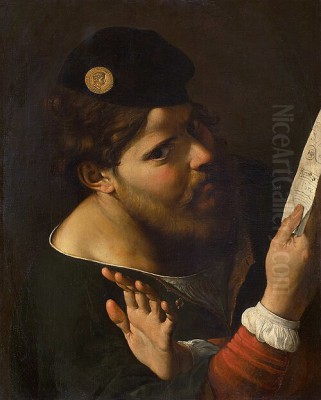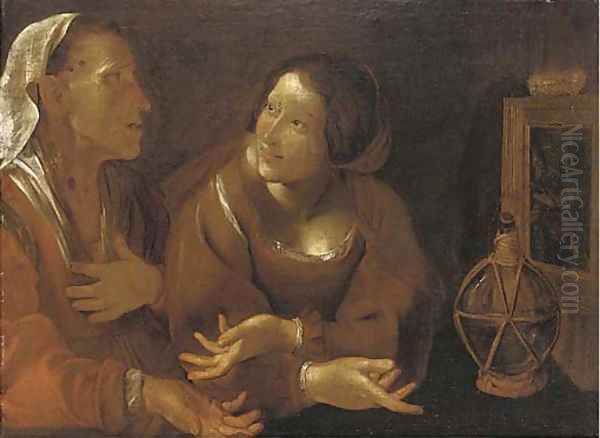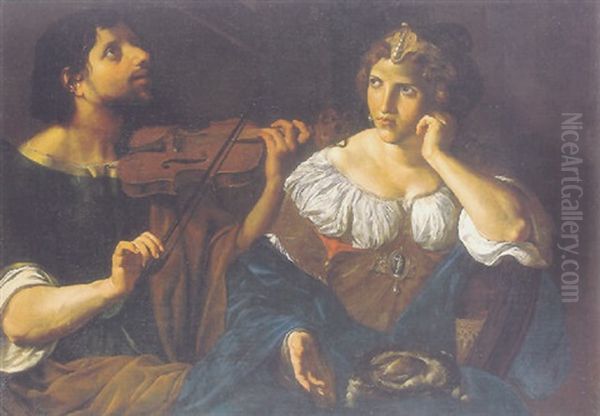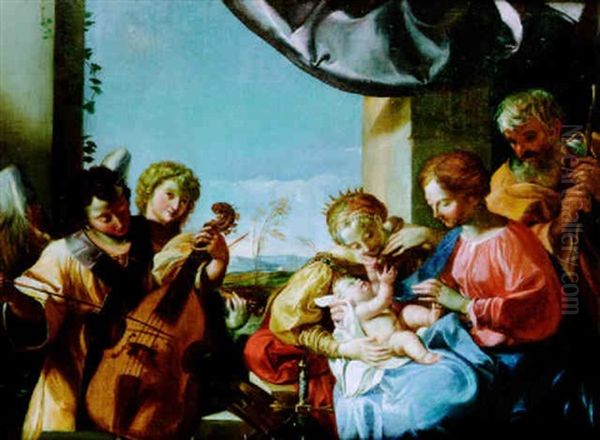
Angelo Caroselli, an Italian painter active during the vibrant Baroque period, remains a figure of considerable interest and some complexity within art historical discourse. Born in Rome in 1585 and passing away in the same city in 1652, Caroselli's life spanned a transformative era in European art. He is particularly noted for his exceptional skill as a copyist and an imitator of other artists' styles, most notably that of Michelangelo Merisi da Caravaggio, yet he also developed a distinctive personal manner that has earned him a unique, if sometimes debated, place in the annals of art.
Early Life and Artistic Formation
The precise details of Angelo Caroselli's early training are somewhat shrouded, with evidence suggesting he was largely self-taught. This notion is supported by accounts that he honed his skills through diligent practice, meticulously copying the works of established masters and frequently painting self-portraits to refine his technique. Such a path was not entirely uncommon in an age where formal academies were still evolving, and an artist's ability to learn by observation and emulation was highly valued.
His formative years saw him travel, absorbing the diverse artistic currents of Italy. A documented visit to Florence in 1610 would have exposed him to the rich heritage of the Renaissance masters, as well as the burgeoning Baroque sensibilities. By 1615, he had journeyed to Naples, another critical artistic hub, then under Spanish influence and a city where Caravaggio himself had worked and left an indelible mark. These experiences undoubtedly contributed to the eclectic nature of his later output.
The Roman Milieu and the Shadow of Caravaggio
Rome, however, was the primary theater of Caroselli's career. He operated within a bustling artistic environment, profoundly shaped by the revolutionary art of Caravaggio. Caravaggio's dramatic use of chiaroscuro (strong contrasts between light and dark), his unflinching realism, and his preference for depicting religious and mythological scenes with an intense, often raw, human emotion had a seismic impact on his contemporaries. Caroselli became one of the many "Caravaggisti," artists who adopted and adapted aspects of the master's style.

Caroselli’s engagement with Caravaggism was not superficial. He produced works of high quality in this vein, demonstrating a deep understanding of its principles. His paintings often feature the characteristic tenebrism – figures emerging from shadowy backgrounds, illuminated by a stark, directional light source – that imbues the scenes with a palpable sense of drama. He joined a cohort of artists in Rome, including figures like Bartolomeo Manfredi, who popularized "Caravaggesque" genre scenes, as well as Orazio Gentileschi and his talented daughter Artemisia Gentileschi, Valentin de Boulogne, and the Frenchman Simon Vouet, all of whom explored the potential of this new, powerful visual language. The influence also extended to artists like Jusepe de Ribera, a Spaniard active in Naples, whose work shares a similar dramatic intensity.
Master of Pastiche and the Art of Copying
One of Caroselli's most defining characteristics was his extraordinary talent for pastiche – creating works in the style of other artists – and for producing outright copies. In the 17th century, the concept of artistic originality differed from modern sensibilities. Copying was a legitimate way to learn, to disseminate famous compositions, and to satisfy patron demand for works by celebrated masters, especially if the originals were inaccessible or prohibitively expensive.
Caroselli excelled in this domain. His technical facility allowed him to replicate the stylistic nuances of various painters with remarkable fidelity. This skill brought him both renown and, at times, controversy. He was known to create works that could easily be mistaken for those of the artists he emulated, leading to complex issues of attribution that continue to challenge art historians. His ability to absorb and reproduce different artistic idioms speaks to a keen observational power and a versatile hand.
A notable instance of his work as a copyist is his rendition of Nicolas Poussin's The Plague at Ashdod. This commission came from Fabrizio Valguarnera, a Sicilian nobleman and art collector, around 1631. Poussin, a French classicist painter working in Rome, was gaining significant acclaim. Caroselli's copy was reportedly so skillful that it was highly praised, demonstrating his capacity to engage even with styles quite different from the Caravaggesque mainstream he often inhabited.
Key Works and Thematic Concerns
Beyond his copies, Caroselli produced a body of original work that reveals his own artistic preoccupations. Allegory of Vanity is a frequently cited example, a theme popular in Baroque art. Such paintings, often featuring a beautiful young woman contemplating symbols of transience like skulls, wilting flowers, or jewels, served as moralizing reminders of the fleeting nature of earthly pleasures and beauty. Caroselli's interpretations of this theme are typically imbued with a Caravaggesque intensity and psychological depth.

Another intriguing work is Lesbia Mourning her Pet Sparrow, inspired by a poem by the Roman poet Catullus. This piece showcases his ability to handle classical subjects with a tender, human touch, again often employing the dramatic lighting characteristic of his style. His Pietà (Lamentation over the Dead Christ) demonstrates his capacity for conveying profound religious emotion, a staple of Baroque art. The figures are often rendered with a sculptural solidity, their grief made palpable through expressive gestures and chiaroscuro.
Caroselli also ventured into less conventional subject matter, including scenes of witchcraft and sorcery. These works, sometimes created in collaboration with his student Pietro Paolini, tap into a fascination with the occult and the supernatural that was prevalent in the 17th century. These paintings often feature enigmatic figures, alchemical symbols, and an atmosphere of mystery, distinguishing them from more traditional religious or mythological narratives. Musical themes also appear in his oeuvre, with figures playing instruments, reflecting the importance of music in Baroque culture and its frequent association with allegorical or genre scenes.
The Relationship with Pietro Paolini
Angelo Caroselli's role as a teacher is primarily associated with Pietro Paolini (1603-1681), an artist from Lucca. Paolini spent a significant period in Rome, from around 1619 to the late 1620s or early 1630s, and it was during this time that he studied with Caroselli. The relationship appears to have been close, with the two artists reportedly collaborating on several works.
The stylistic similarities between master and pupil can be striking, sometimes making it difficult to definitively attribute certain paintings to one or the other. This is particularly true for some of the genre scenes and depictions of musicians or sorcerers. Paolini absorbed Caroselli's Caravaggesque tendencies but later developed his own distinct style upon his return to Lucca. The decision for Caroselli, an artist of somewhat unconventional standing, to teach Paolini, who came from a noble Lucchese family, has been noted by biographers as an interesting aspect of their connection.
Patronage and Commissions
Like all artists of his time, Caroselli relied on patronage to sustain his career. The aforementioned Fabrizio Valguarnera was a significant patron, commissioning the copy of Poussin's Plague at Ashdod. Valguarnera was a colorful figure, himself implicated in art theft and dealings with less scrupulous artists, which adds another layer to Caroselli's association with him.

While detailed records of all his patrons are not exhaustive, it is understood that Caroselli worked for various private collectors in Rome. The nature of his output – skilled copies, original Caravaggesque pieces, and more idiosyncratic works – suggests he catered to a diverse clientele. There is also some indication of potential involvement with projects related to Pope Urban VIII's extensive artistic programs, particularly concerning decorative schemes for altars, though the specifics remain somewhat elusive. The Church, alongside noble families and wealthy merchants, formed the backbone of art patronage in Baroque Rome.
Controversies, Anecdotes, and Reputation
Caroselli's life was not without its share of colorful episodes and controversies, which contributed to his somewhat eccentric reputation. His skill as an imitator occasionally veered into territory that might be considered forgery by modern standards. Giovanni Baglione, a contemporary artist and biographer (and a rival of Caravaggio), described Caroselli as a painter adept at imitation, hinting at the ambiguous nature of this talent.
One famous anecdote, recounted by the 17th-century biographer Filippo Baldinucci, tells of a cardinal who sought Caroselli's expert opinion on a painting believed to be by the Venetian Renaissance master Titian. After careful examination, Caroselli is said to have confessed that the work was, in fact, his own creation. This incident, whether entirely factual or embellished, highlights his remarkable ability to mimic the styles of even the most revered artists, potentially to the point of deceiving connoisseurs.
His private life also attracted comment. Some contemporary sources suggest he led a somewhat dissolute lifestyle, allegedly spending more time with courtesans than with his family. While such accounts must be treated with caution, often colored by the biographer's own biases, they contribute to the image of Caroselli as a non-conformist figure.
Furthermore, Caroselli was not solely a practitioner; he reportedly engaged with art theory, allegedly writing on the paragone – the debate comparing the merits of painting versus sculpture. This intellectual pursuit, if substantiated, would add another dimension to his artistic persona, suggesting an engagement with the theoretical underpinnings of his craft.
Artistic Style and Technique Revisited
Caroselli's artistic style is a fascinating amalgamation. The foundation is undeniably Caravaggesque, evident in his dramatic use of light and shadow, his robust, naturalistic figures, and the emotional intensity he brought to his subjects. However, he was not a slavish follower. His palette could sometimes be richer and more varied than that of the stricter Caravaggisti.
His experience copying artists like Poussin also indicates a capacity for understanding and reproducing more classical compositional structures and a smoother, more idealized rendering of form when required. His figures often possess a tangible, almost sculptural quality, their forms clearly defined by the interplay of light and shade. He was adept at capturing varied textures, from the sheen of silk to the roughness of peasant cloth or the coldness of stone.
His compositions, while often dynamic in the Baroque fashion, could also display a careful arrangement of figures and objects to create a focused narrative or allegorical point. The psychological engagement of his figures, whether in moments of religious ecstasy, quiet contemplation, or mischievous intrigue, is a recurring feature of his work.
Influence and Legacy in Art History
Assessing Angelo Caroselli's influence is a nuanced task. As a prominent member of the Caravaggesque movement in Rome, he contributed to the dissemination and popularization of this influential style. His works, including his copies, would have been seen by other artists and collectors, potentially inspiring them or providing models.
His student, Pietro Paolini, carried aspects of his style back to Lucca, contributing to the spread of Caravaggesque naturalism outside of Rome. More broadly, the Caravaggesque movement had a profound impact across Europe, influencing artists in Spain (like Ribera, Velázquez), France (Georges de La Tour), and the Netherlands (the Utrecht Caravaggisti such as Gerrit van Honthorst and Dirck van Baburen). While Caroselli might not have been a primary innovator on the scale of Caravaggio himself, his competent and sometimes brilliant interpretations played a role in this wider artistic current.
Art historians continue to grapple with Caroselli's oeuvre. The issues of attribution, given his skill as a copyist and his collaborations, mean that defining the precise boundaries of his work can be challenging. Some critics have historically viewed him as a talented but ultimately secondary figure, an eclectic whose primary strength lay in imitation rather than groundbreaking originality. Others, however, emphasize the quality and distinctive character of his best works, arguing for a more prominent place in the rich tapestry of Italian Baroque art. Artists like Guido Reni or Luca Giordano, who achieved greater fame, operated in partly overlapping spheres, but Caroselli carved his own particular niche.
Conclusion: An Artist of Dualities
Angelo Caroselli emerges from the historical record as an artist of intriguing dualities. He was a master of imitation who nonetheless possessed a recognizable personal style. He moved within the orbit of Caravaggio's revolutionary art yet was capable of engaging with the classicism of Poussin. His life seems to have been as colorful and unconventional as some of his chosen subject matter.
While the debates surrounding his originality and the precise extent of his oeuvre may continue, his skill and the unique character of his paintings are undeniable. He remains a testament to the diverse talents that flourished in the fertile artistic environment of 17th-century Rome, an artist whose work invites closer inspection and offers a fascinating window into the complexities of Baroque art, where the lines between imitation, inspiration, and innovation were often compellingly blurred. His legacy is that of a highly skilled painter who, while adept at speaking in the voices of others, also managed to articulate his own distinct artistic concerns.